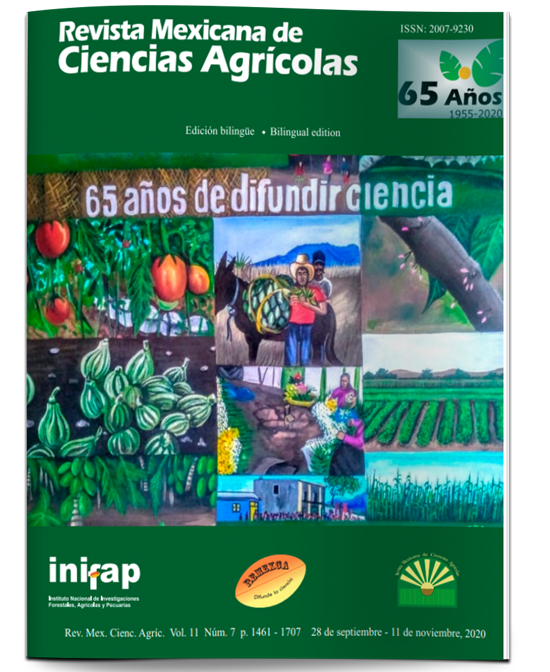Susceptibility of native maize populations and preference of the weevil in Yucatán, México
DOI:
https://doi.org/10.29312/remexca.v11i7.2081Keywords:
endosperm, color preference, Nal t’eel, perforated seed, purple corn, red cornAbstract
One of the problems with the storage of seeds in corn is the presence of pests that reduce quality. To deal with this problem, materials with little or no susceptibility are used. The native varieties of maize in Yucatan are reservoirs of genes for resistance to storage pests. The objective of this study was to evaluate the attack of weevils (Sitophilus zeamais Motschulsky) in eight populations of corn and two control varieties. To determine the susceptibility, 100 seeds of each population were exposed to the presence of 100 weevils for 15 days, with 10 repetitions, the variables were number of live weevils, weight loss and percentage of damaged grain. Preference was determined by placing 100 seeds from each population and 1 000 weevils in the same container, they were stored for 30 days and repeated five times. The percentage of grain damaged by color was recorded. The highest susceptibility was presented in the populations Chichen Itza, Sac beh and Nal t’eel white, the first two registered the highest percentage of damaged grain, with 15% higher than the other populations evaluated, while the Nal t’eel White population registered 6.1% above the lower loss. The insect’s preference was for white grains. The pericarp (0.495) and scutellum (0.418) showed a relationship with the presence of damaged grains. There are differences in the susceptibility and preference of the evaluated populations, which indicates variability that can be used in genetic improvement programs.
Downloads
Downloads
Published
How to Cite
Issue
Section
License
The authors who publish in Revista Mexicana de Ciencias Agrícolas accept the following conditions:
In accordance with copyright laws, Revista Mexicana de Ciencias Agrícolas recognizes and respects the authors’ moral right and ownership of property rights which will be transferred to the journal for dissemination in open access. Invariably, all the authors have to sign a letter of transfer of property rights and of originality of the article to Instituto Nacional de Investigaciones Forestales, Agrícolas y Pecuarias (INIFAP) [National Institute of Forestry, Agricultural and Livestock Research]. The author(s) must pay a fee for the reception of articles before proceeding to editorial review.
All the texts published by Revista Mexicana de Ciencias Agrícolas —with no exception— are distributed under a Creative Commons License Attribution-NonCommercial 4.0 International (CC BY-NC 4.0), which allows third parties to use the publication as long as the work’s authorship and its first publication in this journal are mentioned.
The author(s) can enter into independent and additional contractual agreements for the nonexclusive distribution of the version of the article published in Revista Mexicana de Ciencias Agrícolas (for example include it into an institutional repository or publish it in a book) as long as it is clearly and explicitly indicated that the work was published for the first time in Revista Mexicana de Ciencias Agrícolas.
For all the above, the authors shall send the Letter-transfer of Property Rights for the first publication duly filled in and signed by the author(s). This form must be sent as a PDF file to: revista_atm@yahoo.com.mx; cienciasagricola@inifap.gob.mx; remexca2017@gmail.
This work is licensed under a Creative Commons Attribution-Noncommercial 4.0 International license.



